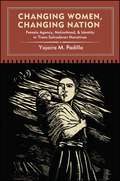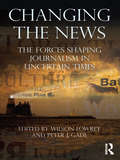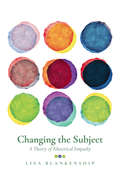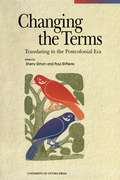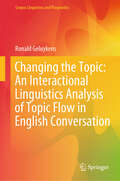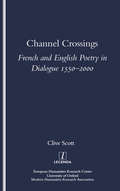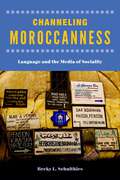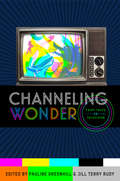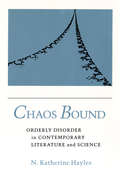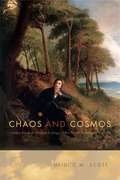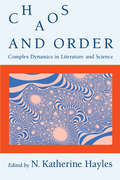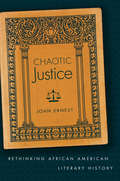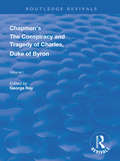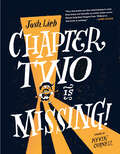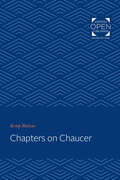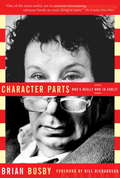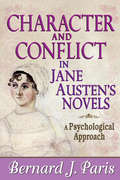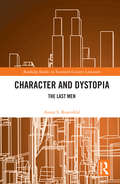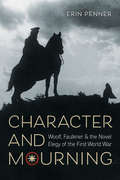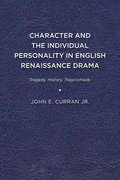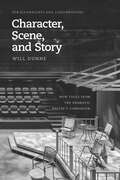- Table View
- List View
Changing Women, Changing Nation: Female Agency, Nationhood, and Identity in Trans-Salvadoran Narratives (SUNY series in Latin American and Iberian Thought and Culture)
by Yajaira M. PadillaChanging Women, Changing Nation explores the literary representations of women in Salvadoran and US-Salvadoran narratives during the span of the last thirty years. This exploration covers Salvadoran texts produced during El Salvador's civil war (1980–1992) and the current postwar period, as well as US-Salvadoran works of the last two decades that engage the topic of migration and second-generation ethnic incorporation into the United States. Rather than think of these two sets of texts as constituting separate literatures, Yajaira M. Padilla conceives of them as part of the same corpus, what she calls "trans-Salvadoran narratives"—works that dialogue with each other and draw attention to El Salvador's burgeoning transnational reality. Through depictions of women in trans-Salvadoran narratives, Padilla elucidates a "story" of female agency and nationhood that extends beyond El Salvador's national borders and imaginings.
Changing the News: The Forces Shaping Journalism in Uncertain Times (Routledge Communication Series)
by Wilson Lowrey Peter J. GadeChanging the News examines the difficulties in changing news processes and practices in response to the evolving circumstances and struggles of the journalism industry. The editors have put together this volume to demonstrate why the prescriptions employed to salvage the journalism industry to date haven’t worked, and to explain how constraints and pressures have influenced the field’s responses to challenges in an uncertain, changing environment. If journalism is to adjust and thrive, the following questions need answers: Why do journalists and news organizations respond to uncertainties in the ways they do? What forces and structures constrain these responses? What social and cultural contexts should we take into account when we judge whether or not journalism successfully responds and adapts? The book tackles these questions from varying perspectives and levels of analysis, through chapters by scholars of news sociology and media management. Changing the News details the forces that shape and challenge journalism and journalistic culture, and explains why journalists and their organizations respond to troubles, challenges and uncertainties in the way they do.
Changing the Subject: A Theory of Rhetorical Empathy
by Lisa BlankenshipChanging the Subject explores ways of engaging across difference. In this first book-length study of the concept of empathy from a rhetorical perspective, Lisa Blankenship frames the classical concept of pathos in new ways and makes a case for rhetorical empathy as a means of ethical rhetorical engagement. The book considers how empathy can be a deliberate, conscious choice to try to understand others through deep listening and how language and other symbol systems play a role in this process that is both cognitive and affective. Departing from agonistic win-or-lose rhetoric in the classical Greek tradition that has so strongly influenced Western thinking, Blankenship proposes that we ourselves are changed (“changing the subject” or the self) when we focus on trying to understand rather than simply changing an Other. This work is informed by her experiences growing up in the conservative South and now working as a professor in New York City, as well as the stories and examples of three people working across profound social, political, class, and gender differences: Jane Addams’s activist work on behalf of immigrants and domestic workers in Gilded Age Chicago; the social media advocacy of Brazilian rap star and former maid Joyce Fernandes for domestic worker labor reform; and the online activist work of Justin Lee, a queer Christian who advocates for greater understanding and inclusion of LGBTQ+ people in conservative Christian churches. A much-needed book in the current political climate, Changing the Subject charts new theoretical ground and proposes ways of integrating principles of rhetorical empathy in our everyday lives to help fight the temptations of despair and disengagement. The book will appeal to students, scholars, and teachers of rhetoric and composition as well as people outside the academy in search of new ways of engaging across differences.
Changing the Terms: Translating in the Postcolonial Era
by Sherry Simon Paul St-PierreThis volume explores the theoretical foundations of postcolonial translation in settings as diverse as Malaysia, Ireland, India and South America. Changing the Terms examines stimulating links that are currently being forged between linguistics, literature and cultural theory.
Changing the Topic: An Interactional Linguistics Analysis of Topic Flow in English Conversation (Corpus Linguistics and Pragmatics)
by Ronald GeluykensThis book presents an in-depth analysis of how discourse topics are introduced, maintained, and closed in British English conversation. It highlights the crucial role of real-time negotiation and turn-taking in ensuring cohesive topic flow. Using an inductive, bottom-up approach, the book explores topicality through an operational definition grounded in the traditional Discourse Analysis (DA) concept of given versus new information. This operational framework is used to identify potential topic shifts and is complemented by a detailed micro-analysis of interactional sequences. Inspired by Conversation Analysis (CA), it investigates how topics are negotiated, trouble spots are resolved, and cohesion is collaboratively achieved. The combination of DA and CA methodology, combined with its attention to the linguistic resources employed by participants, explores an exciting new area of Interactional Linguistics. The book offers future avenues for potential contrastive studies on topic flow which take into account regional, social, typological, stylistic, and diachronic variation. It is of interest to researchers working in the fields of information flow, conversational interaction, and functional linguistics in general. Its theoretical apparatus contributes to a clearer understanding of the elusive notion of topicality.
Channel Crossings: French and English Poetry in Dialogue 1550-2000
by Clive Scott"Scott's subtle and adventurous analysis breaks new ground in textual understanding, while his translations radically challenge established orthodoxies. As he crosses back and forth between French and English poetry, he has illuminating encounters with a wide range of poets, from Labe and Shakespeare to Auden and Jaccottet. The embodiment of gender in the sonnet; the performance of the dramatic voice; the inflexions of the self in the voice of lyric verse; the 'landscaping' of nature in the line of verse; the interventions of the translator in the peculiar lives of the prose poem and free verse; the tasks of the translator and the comparatist in a new age - these are some of the issues addressed by Clive Scott in a sequence of essays as absorbing as they are original. ""Channel Crossings"" is the recipient of the R. H. Gapper Prize for 2004. The Prize, which is judged by the Society for French Studies, recognises the best publication of its year by any French studies scholar working in the United Kingdom or Ireland. The citation noted: In his book, Clive Scott gives a subtle and adventurous account of how processes of cultural exchange have played an active and enduring role in the development of the language of poetry in French and English over a period of several centuries...Clive Scott's book was one of a number of very impressive works published in 2002. The judges' choice was made in the light of the book's originality and its likely impact on wider critical debate on the language of poetry and on questions of method and approach in comparative literature."
Channeling Moroccanness: Language and the Media of Sociality
by Becky L. SchulthiesHonorable Mention, 2022 L. Carl Brown AIMS Book Prize in North African StudiesWhat does it mean to connect as a people through mass media? This book approaches that question by exploring how Moroccans engage communicative failure as they seek to shape social and political relations in urban Fez. Over the last decade, laments of language and media failure in Fez have focused not just on social relations that used to be and have been lost but also on what ought to be and had yet to be realized. Such laments have transpired in a range of communication channels, from objects such as devotional prayer beads and remote controls; to interactional forms such as storytelling, dress styles, and orthography; to media platforms like television news, religious stations, or WhatsApp group chats. Channeling Moroccanness examines these laments as ways of speaking that created Moroccanness, the feeling of participating in the ongoing formations of Moroccan relationality. Rather than furthering the discourse about Morocco’s conflict between liberal secularists and religious conservatives, this ethnography shows the subtle range of ideologies and practices evoked in Fassi homes to calibrate Moroccan sociality and political consciousness.
Channeling Wonder: Fairy Tales on Television
by Pauline Greenhill Jill Terry RudyTelevision has long been a familiar vehicle for fairy tales and is, in some ways, an ideal medium for the genre. Both more mundane and more wondrous than cinema, TV magically captures sounds and images that float through the air to bring them into homes, schools, and workplaces. Even apparently realistic forms, like the nightly news, routinely employ discourses of "once upon a time," "happily ever after," and "a Cinderella story." In Channeling Wonder: Fairy Tales on Television, Pauline Greenhill and Jill Terry Rudy offer contributions that invite readers to consider what happens when fairy tale, a narrative genre that revels in variation, joins the flow of television experience. Looking in detail at programs from Canada, France, Italy, Japan, the UK, and the U.S., this volume's twenty-three international contributors demonstrate the wide range of fairy tales that make their way into televisual forms. The writers look at fairy-tale adaptations in musicals like Rodgers and Hammerstein's Cinderella, anthologies like Jim Henson's The Storyteller, made-for-TV movies like Snow White: A Tale of Terror, Bluebeard, and the Red Riding Trilogy, and drama serials like Grimm and Once Upon a Time. Contributors also explore more unexpected representations in the Carosello commercial series, the children's show Super Why!, the anime series Revolutionary Girl Utena, and the live-action dramas Train Man and Rich Man Poor Woman. In addition, they consider how elements from familiar tales, including "Hansel and Gretel," "Little Red Riding Hood," "Beauty and the Beast," "Snow White," and "Cinderella" appear in the long arc serials Merlin, Buffy the Vampire Slayer, and Dollhouse, and in a range of television formats including variety shows, situation comedies, and reality TV. Channeling Wonder demonstrates that fairy tales remain ubiquitous on TV, allowing for variations but still resonating with the wonder tale's familiarity. Scholars of cultural studies, fairy-tale studies, folklore, and television studies will enjoy this first-of-its-kind volume.
Chaos Bound: Orderly Disorder in Contemporary Literature and Science
by N. Katherine HaylesN. Katherine Hayles here investigates parallels between contemporary literature and critical theory and the science of chaos. She finds in both scientific and literary discourse new interpretations of chaos, which is seen no longer as disorder but as a locus of maximum information and complexity. She examines structures and themes of disorder in The Education of Henry Adams, Doris Lessing’s Golden Notebook, and works by Stanislaw Lem. Hayles shows how the writings of poststructuralist theorists including Barthes, Lyotard, Derrida, Serres, and de Man incorporate central features of chaos theory.
Chaos and Cosmos: Literary Roots of Modern Ecology in the British Nineteenth Century
by Heidi C. ScottIn Chaos and Cosmos, Heidi Scott integrates literary readings with contemporary ecological methods to investigate two essential and contrasting paradigms of nature that scientific ecology continues to debate: chaos and balance. Ecological literature of the Romantic and Victorian eras uses environmental chaos and the figure of the balanced microcosm as tropes essential to understanding natural patterns, and these eras were the first to reflect upon the ecological degradations of the Industrial Revolution. Chaos and Cosmos contends that the seed of imagination that would enable a scientist to study a lake as a microcosmic world at the formal, empirical level was sown by Romantic and Victorian poets who consciously drew a sphere around their perceptions in order to make sense of spots of time and place amid the globalizing modern world. This study’s interest goes beyond likening literary tropes to scientific aesthetics; it aims to theorize the interdisciplinary history of the concepts that underlie our scientific understanding of modern nature. Paradigmatic ecological ideas such as ecosystems, succession dynamics, punctuated equilibrium, and climate change are shown to have a literary foundation that preceded their status as theories in science. This book represents an elevation of the prospects of ecocriticism toward fully developed interdisciplinary potentials of literary ecology.
Chaos and Cosmos: Literary Roots of Modern Ecology in the British Nineteenth Century
by Heidi C. ScottIn Chaos and Cosmos, Heidi Scott integrates literary readings with contemporary ecological methods to investigate two essential and contrasting paradigms of nature that scientific ecology continues to debate: chaos and balance. Ecological literature of the Romantic and Victorian eras uses environmental chaos and the figure of the balanced microcosm as tropes essential to understanding natural patterns, and these eras were the first to reflect upon the ecological degradations of the Industrial Revolution. Chaos and Cosmos contends that the seed of imagination that would enable a scientist to study a lake as a microcosmic world at the formal, empirical level was sown by Romantic and Victorian poets who consciously drew a sphere around their perceptions in order to make sense of spots of time and place amid the globalizing modern world. This study’s interest goes beyond likening literary tropes to scientific aesthetics; it aims to theorize the interdisciplinary history of the concepts that underlie our scientific understanding of modern nature. Paradigmatic ecological ideas such as ecosystems, succession dynamics, punctuated equilibrium, and climate change are shown to have a literary foundation that preceded their status as theories in science. This book represents an elevation of the prospects of ecocriticism toward fully developed interdisciplinary potentials of literary ecology.
Chaos and Order: Complex Dynamics in Literature and Science (New Practices Of Inquiry Ser.)
by N. Katherine HaylesThe scientific discovery that chaotic systems embody deep structures of order is one of such wide-ranging implications that it has attracted attention across a spectrum of disciplines, including the humanities. In this volume, fourteen theorists explore the significance for literary and cultural studies of the new paradigm of chaotics, forging connections between contemporary literature and the science of chaos. They examine how changing ideas of order and disorder enable new readings of scientific and literary texts, from Newton's Principia to Ruskin's autobiography, from Victorian serial fiction to Borges's short stories. N. Katherine Hayles traces shifts in meaning that chaos has undergone within the Western tradition, suggesting that the science of chaos articulates categories that cannot be assimilated into the traditional dichotomy of order and disorder. She and her contributors take the relation between order and disorder as a theme and develop its implications for understanding texts, metaphors, metafiction, audience response, and the process of interpretation itself. Their innovative and diverse work opens the interdisciplinary field of chaotics to literary inquiry.
Chaotic Justice: Rethinking African American Literary History
by John ErnestWhat is African American about African American literature? Why identify it as a distinct tradition? John Ernest contends that too often scholars have relied on naÏve concepts of race, superficial conceptions of African American history, and the marginalization of important strains of black scholarship. With this book, he creates a new and just retelling of African American literary history that neither ignores nor transcends racial history. Ernest revisits the work of nineteenth-century writers and activists such as Henry "Box" Brown, Frederick Douglass, Harriet Wilson, William Wells Brown, and Sojourner Truth, demonstrating that their concepts of justice were far more radical than those imagined by most white sympathizers. He sheds light on the process of reading, publishing, studying, and historicizing this work during the twentieth century. Looking ahead to the future of the field, Ernest offers new principles of justice that grant fragmented histories, partial recoveries, and still-unprinted texts the same value as canonized works. His proposal is both a historically informed critique of the field and an invigorating challenge to present and future scholars.
Chapman's The Conspiracy and Tragedy of Charles, Duke of Byron (Routledge Revivals)
by George RayOriginally published in 1979, this two-volume modern spelling of George Chapman's The Conspiracy and Tragedy of Charles, Duke of Byron is split into two parts: a critical introduction and commentary, and the texts of the double-play, the Conspiracy (contained in Volume I) and the Tragedy (Volume II). The Critical Introduction comprises five chapters treating the date, sources, scholarly tradition, interpretation, and unity of The Conspiracy and Tragedy of Byron.
Chapter Two is Missing
by Josh Lieb"Very few books are this entertaining to read. Even fewer are literally an active crime scene. Please help find Chapter 2. Without it, this book is nothing." -John Oliver, host of HBO's Last Week Tonight Chapter Two is Missing is a hilarious picture book mystery starring a hopelessly lost narrator, an unqualified detective, and a very sneaky janitor, who are all surprised to discover that second chapter of the very book of which they are a part is--gasp--missing!Do not be alarmed, but the second chapter of this book appears to be missing! It was here a minute ago, but now it seems to have simply walked off. Not only that, but some of the punctuation has gone topsy-turvy, a bunch of letter Ms are hiding in Chapter 5, and Chapter 45 appears to be from another book entirely! The narrator is going to need some assistance getting things in order, especially with the unhelpful detective who keeps butting in and that shifty janitor lurking about. Luckily he has you--the reader--to help! From Emmy winning comedy writer and producer Josh Lieb, Chapter Two is Missing is a hilarious whodunit, an irreverent look at storytelling, and perfect for fans of Snappsy the Alligator (Did Not Ask to Be in This Book) and The Book With No Pictures.
Chapters on Chaucer
by Kemp MaloneOriginally published in 1951. Kemp Malone provides a guide to reading Chaucer's work that is intended for readers who are familiar with Chaucer's work but who are not Chaucerians. The first chapter places Chaucer in the historical and literary context of the fourteenth century. The other essays focus on Chaucer's poetry by providing historicized interpretations of Chaucer's work and methods for each poem.
Character Parts
by Brian BusbyEver wondered where novelists get the inspiration for their characters? Why the hero or villain of your favourite book seems oddly familiar? Who inspired Mordecai Richler to create Bernard Gursky; Margaret Atwood to create Zenia in The Robber Bride? In which novel does Northrop Frye appear (as a character named Morton Hyland)? The answers can be found in Character Parts, Brian Busby's irreverent yet authoritative guide to who's really who in Canadian literature. The most original and entertaining reference book to be published in years, Character Parts is the behind-the-scenes look at CanLit we have all been waiting for.Brian Busby settles the suspicions that arise when a fictional character reminds you of a real-life one, listing the sources for characters from the whole of Canadian literature. His canvas stretches from the settlers who inspired 1852's Roughing It in the Bush to Glenn Gould's appearance as Nathaniel Orlando Gow in Tim Wynne-Jones' The Maestro, and beyond. But Character Parts is also chock-full of fascinating, less famous people who have been immortalized in Canadian books: seductive Alberta politicians, British army generals, anarchists, models, aristocrats -- and, of course, parents, siblings and ex-spouses.Authoritative, but presented with a light touch, Character Parts is as at home in a university library as on a bathroom shelf. It's that rare find: an exemplary reference book that is also an absolutely entertaining read in its own right.From the Hardcover edition.
Character and Caricature, 1660-1820
by Jennifer Buckley Montana Davies-ShuckThis edited collection offers a reappraisal of character as a precondition for caricature and addresses how the two began to merge, becoming increasingly interlinked over the course of the long eighteenth century. It emphasises the need to understand character more fully, arguing that the nuances and origins of caricature can only be appreciated in light of the genre’s prehistory and reliance on popular character types. Interdisciplinary and multidisciplinary in approach, the collection makes use of a variety of theories and addresses fiction in its broadest sense, expanding and reconceptualising critical, historical and theoretical discussion of character. Chapters draw from disability studies, cultural materialism, gender studies and the history of sexuality, spatial theory and performance studies.
Character and Conflict in Jane Austen's Novels: A Psychological Approach
by Bernard J. ParisIn Character and Conflict in Jane Austen's Novels , Bernard J. Paris offers an analysis of the protagonists in four of Jane Austen's most popular novels. His analysis reveals them to be brilliant mimetic creations who often break free of the formal and thematic limitations placed upon them by Austen. Paris traces the powerful tensions between form, theme, and mimesis in Mansfield Park , Emma , Pride and Prejudice , and Persuasion . Paris uses Northrop Frye's theory of comic forms to analyse and describe the formal structure of the novels, and Karen Horney's psychological theories to explore the personalities and inner conflicts of the main characters. The concluding chapter turns from the characters to their creator, employing the Horneyan categories of self-effacing, detached, and expansive personality types to interpret Jane Austen's own personality. Readers of Jane Austen will find much that is new and challenging in this study. It is one of the few books to recognise and pay tribute to Jane Austen's genius in characterisation. Anyone who reads this book will come away with a new understanding of Austen's heroines as imagined human beings and also with a deeper feeling for the troubled humanity of the author herself.
Character and Dystopia: The Last Men (Routledge Studies in Twentieth-Century Literature)
by Aaron S. RosenfeldThis is the first extended study to specifically focus on character in dystopia. Through the lens of the "last man" figure, Character and Dystopia: The Last Men examines character development in Yevgeny Zamyatin’s We, Anthony Burgess’s A Clockwork Orange, Kazuo Ishiguro’s Never Let Me Go, Fyodor Dostoevsky’s Notes from Underground, George Orwell’s Nineteen Eighty-Four, Nathanael West’s A Cool Million, David Mamet’s Glengarry Glen Ross, Octavia Butler’s Parable of the Sower, Lois Lowry’s The Giver, Michel Houellebecq’s Submission, Chan Koonchung’s The Fat Years, and Maggie Shen King’s An Excess Male, showing how in the 20th and 21st centuries dystopian nostalgia shades into reactionary humanism, a last stand mounted in defense of forms of subjectivity no longer supported by modernity. Unlike most work on dystopia that emphasizes dystopia’s politics, this book’s approach grows out of questions of poetics: What are the formal structures by which dystopian character is constructed? How do dystopian characters operate differently than other characters, within texts and upon the reader? What is the relation between this character and other forms of literary character, such as are found in romantic and modernist texts? By reading character as crucial to the dystopian project, the book makes a case for dystopia as a sensitive register of modern anxieties about subjectivity and its portrayal in literary works.
Character and Mourning: Woolf, Faulkner, and the Novel Elegy of the First World War
by Erin PennerIn response to the devastating trauma of World War I, British and American authors wrote about grief. The need to articulate loss inspired moving novels by Virginia Woolf and William Faulkner. Woolf criticized the role of Britain in the "war to end all wars," and Faulkner recognized in postwar France a devastation of land and people he found familiar from his life in a Mississippi still recovering from the American Civil War. In Character and Mourning, Erin Penner shows how these two modernist novelists took on the challenge of rewriting the literature of mourning for a new and difficult era.Faulkner and Woolf address the massive war losses from the perspective of the noncombatant, thus reimagining modern mourning. By refusing to let war poets dominate the larger cultural portrait of the postwar period, these novelists negotiated a relationship between soldiers and civilians—a relationship that was crucial once the war had ended. Highlighting their sustained attention to elegiac reinvention over the course of their writing careers—from Jacob’s Room to The Waves, from The Sound and the Fury to Go Down, Moses—Penner moves beyond biographical and stylistic differences to recognize Faulkner and Woolf’s shared role in reshaping elegiac literature in the period following the First World War.
Character and the Individual Personality in English Renaissance Drama: Tragedy, History, Tragicomedy (G - Reference, Information And Interdisciplinary Subjects Ser.)
by John E. CurranCharacter and the Individual Personality in English Renaissance Drama: Tragedy, History, Tragicomedy studies instantiations of the individualistic character in drama, Shakespearean and non-Shakespearean, and some of the Renaissance ideas allowing for and informing them. Setting aside such fraught questions as the history of Renaissance subjectivity and individualism on the one hand and Shakespearean exceptionalism on the other, we can find that in some plays, by a range of different authors and collaborators, a conception has been evidenced of who a particular person is, and has been used to drive the action. This evidence can take into account a number of internal and external factors that might differentiate a person, and can do so drawing on the intellectual context in a number of ways. Ideas with potential to emphasize the special over the general in envisioning the person might come from training in dialectic (thesis vs hypothesis) or in rhetoric (ethopoeia), from psychological frameworks (casuistry, humor theory, and their interpenetration), or from historiography (exemplarity). But though they depicted what we would call personality only intermittently, and with assumptions different from our own about personhood, dramatists sometimes made a priority of representing the workings of a specific mind: the patterns of thought and feeling that set a person off as that person and define that person singularly rather than categorically. Some individualistic characters can be shown to emerge where we do not expect, such as with Fletcherian personae like Amintor, Arbaces, and Montaigne of The Honest Man’s Fortune; some are drawn by playwrights often uninterested in character, such as Chapman’s Bussy D’Ambois, Jonson’s Cicero, and Ford’s Perkin Warbeck; and some appear in being constructed differently from others by the same author, as when Webster’s Bosola is set in contrast to Flamineo, and Marlowe’s Faustus is set against Barabas. But Shakespearean characters are also examined for the particular manner in which each troubles the categorical and exhibits a personality: Othello, Good Duke Humphrey, and Marc Antony. Published by University of Delaware Press. Distributed worldwide by Rutgers University Press.
Character and the Supernatural in Shakespeare and Achebe (Routledge Studies in Speculative Fiction)
by Kenneth UsongoThrough mainly a New Historicist critical approach, this book explores how Shakespeare and Achebe employ supernatural devices such as prophecies, dreams, gods/goddesses, beliefs, and divinations to create complex characters. Even though these features indicate the preponderance of the belief in the supernatural by some people of the Elizabethan, Jacobean, and traditional Igbo societies, Shakespeare and Achebe primarily use the supernatural to represent the states of mind of their protagonists. Both writers appropriate supernatural features to mirror tragic flaws such as ambition, arrogance, impulsiveness, and fear that contribute to the downfall of Macbeth, Lear, Okonkwo, and Ezeulu. We relate to some of these characters because they project our inner minds, principal drives that may be hidden within us. Therefore, Shakespeare and Achebe’s preoccupation with the supernatural adds subtlety to their characterization and enhances their readability by situating their art beyond time, place, or particularity.
Character, Scene, and Story: New Tools from the Dramatic Writer's Companion (Chicago Guides to Writing, Editing, and Publishing)
by Will DunneWill Dunne first brought the workshop experience down to the desk level with The Dramatic Writer’s Companion, offering practical exercises to help playwrights and screenwriters work through the problems that arise in developing their scripts. Now writers looking to further enhance their storytelling process can turn to Character, Scene, and Story. Featuring forty-two new workshop-tested exercises, this sequel to The Dramatic Writer’s Companion allows writers to dig deeper into their scripts by fleshing out images, exploring characters from an emotional perspective, tapping the power of color and sense memory to trigger ideas, and trying other visceral techniques. The guide also includes a troubleshooting section to help tackle problem scenes. Writers with scripts already in progress will find they can think deeper about their characters and stories. And those who are just beginning to write will find the guidance they need to discover their best starting point. The guide is filled with hundreds of examples, many of which have been developed as both plays and films. Character, Scene, and Story is fully aligned with the new edition of The Dramatic Writer’s Companion, with cross-references between related exercises so that writers have the option to explore a given topic in more depth. While both guides can stand alone, together they give writers more than one hundred tools to develop more vivid characters and craft stronger scripts.
